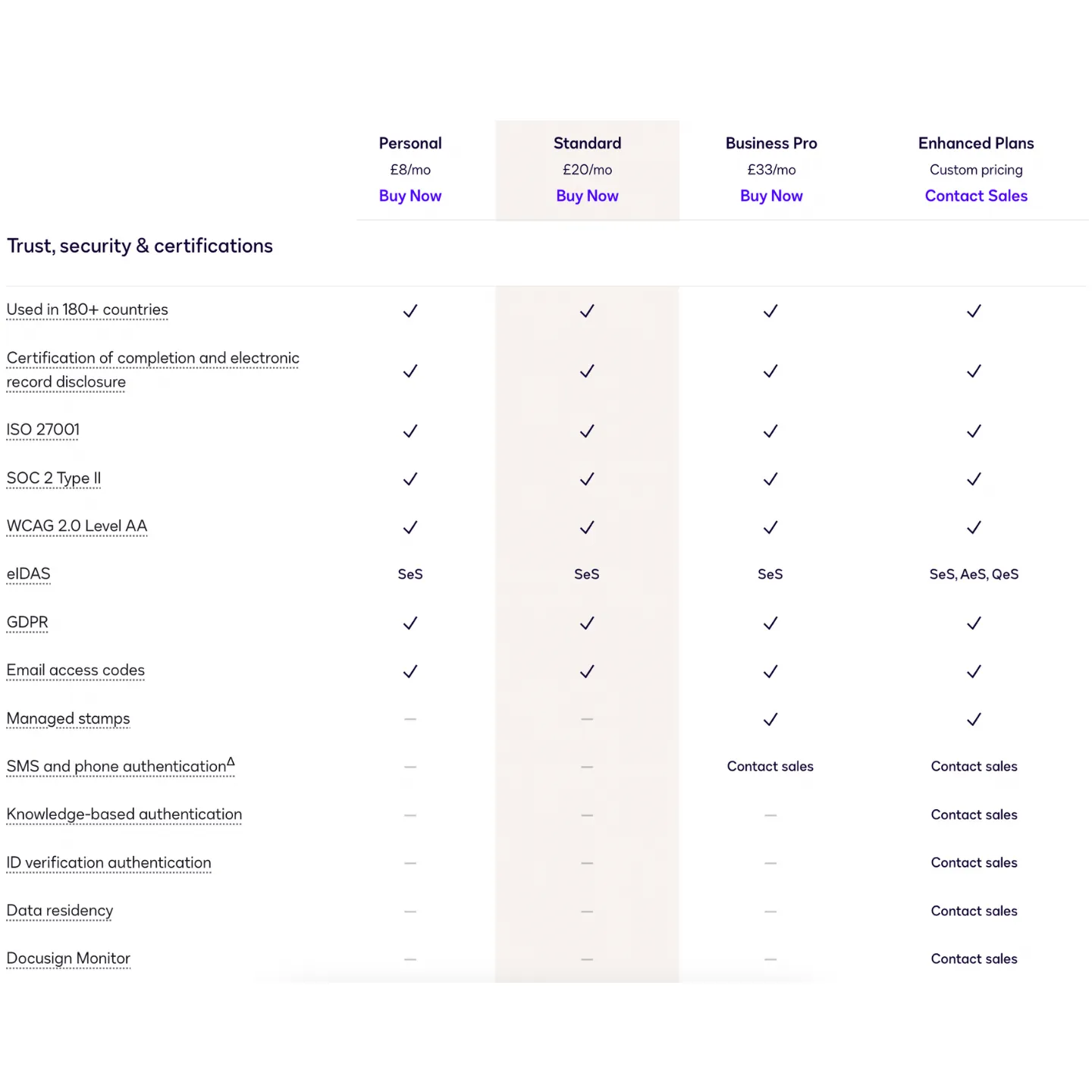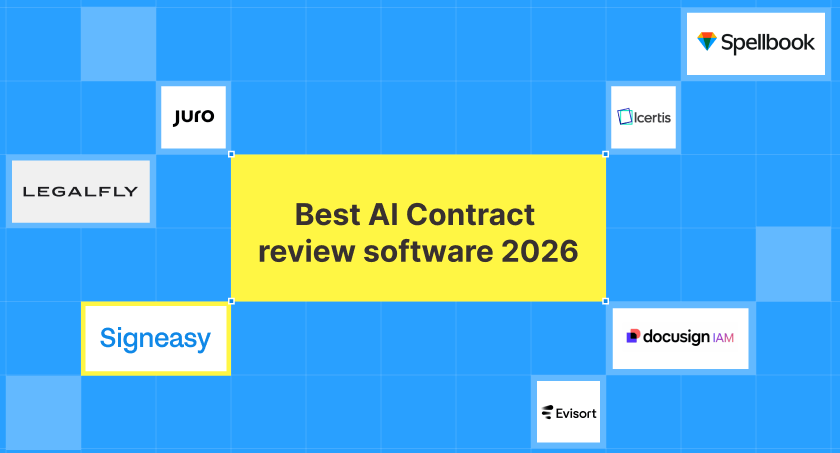Docusign pricing is a hot topic if you’ve been searching for eSignature software. It’s nearly impossible not to come across Docusign, which is often labeled as a leading eSignature platform known for its extensive list of features and premium functionality.
But here’s the catch. Many businesses, even large ones, are starting to feel the pinch of its pricing. Some are even questioning if it’s worth the cost, as you can see from discussions online.
With several alternatives in the market like Signeasy, Dropbox Sign, Adobe Sign, and PandaDoc, comparing Docusign’s and the rest's cost-to-benefit ratio can be infuriating. Should you go ahead with the Docusign pricing, or look for better options?
We worked on this blog to help you make an informed decision. You’ll find out if Docusign’s pricing plans align with your business, or if other alternatives like Signeasy can offer a better pricing structure.
P.S. Check out the complete guide here to learn more about Docusign and its top 13 alternatives.
Let’s get started.
What does Docusign offer?
Docusign is a powerful platform designed to streamline contract workflows and expedite the signature process. At its core, it offers end-to-end electronic signing, enabling users to sign documents from anywhere. Platforms that support free online document signing empower teams to manage agreements from any device, cutting down delays and improving efficiency across departments.
Beyond its eSignature capabilities, Docusign enhances efficiency by auto-populating new agreements, accelerating the review process, and automating contract workflows through templates and connectors.
The platform supports contract management from inception to renewal, ensuring a seamless experience throughout the document lifecycle.
Additionally, Docusign’s tracking features extend beyond just eSignatures; it integrates with major payment gateways to help identify and resolve bottlenecks, minimizing delayed payments.
With its globally compliant security measures, integration options, and smooth interface, Docusign is a standout choice for anyone evaluating eSignature solutions.
Docusign pricing
How we sourced our data
We compiled all pricing and feature details directly from Docusign’s official pricing page, product documentation, and G2 user reviews. This ensures that the comparisons presented here reflect accurate and reliable information for your decision-making.
Docusign pricing plans are separated into four categories which can be paid either monthly or annually. There’s also a Docusign *CLM pricing plan, to manage contracts effectively.

The monthly cost of these plans is costlier by some extra $. It is to be noted that all the plans cover only one user at a time. That’s where it can get expensive.
Here’s an overview of the plans:
Personal: For individuals and sole proprietors dealing with infrequent signature requests. Covers the basic eSignature features.
Standard: For small to medium teams that are more established and need regular collaboration.
Business Pro: For teams dealing with a huge volume of contracts and prefer automating certain aspects of their workflow.
Enhanced: Tailored pricing plan with advanced features like data synchronization, ID validators, conditional routing, etc.
The pricing structure for Docusign can be restrictive for fast-growing companies, as it requires payment for the entire year upfront when users opt for the annual plan.
While the yearly plan for Docusign is cheaper compared to the monthly payment option, the requirement to pay for the entire year in advance can be a significant hurdle for businesses with tighter cash flow.
*CLM: Docusign also offers separate contract-lifecycle management plan. Here, users can automate their entire contract lifecycle, upload agreements into the cloud, enhance collaboration between clients and the company, and facilitate version control and storage. Interested users can request specific pricing from the sales team based on their business needs.

Docusign features
Docusign is hailed for its global compliance measures. It adheres to standards such as ISO 27001, SOC 2 Type II, PCI Data Security Standard, and WCAG 2.0 level AA. It’s also GDPR compliant and offers multiple authenticators like SMS, ID verification, OTPs, etc.

As you can see in the plans above, essential security features like SMS and phone authentication, as well as ID verification, are only available in the higher-tier plans.
Another one of its strong selling points is the option to integrate with 900+ tools, allowing users to streamline data and eliminate incessant app switching. This also helps to add simplicity to the otherwise complicated workflows.
Firms dealing with a high volume of documents can convert their contracts into reusable templates, thus standardizing their contracts across clients.
Additional features include mobile accessibility, allowing users to manage and sign documents on the go; analytics for insights into document processes, customizable workflows, and access to API and developer tools.
While bulk sending, customized branding, and 24/7 live support are only available at additional costs, core features like audit trails, support for 44+ languages, automatic reminders, and reporting are included across all plans.
It is to be noted that Docusign’s Personal plan provides a limit of 5 *envelopes per month. Such a number can be too low for small to medium companies sending a huge outflow of signature requests. Upon reaching the limit, you’ll have to pay extra for each signature request that exceeds your plan limit.

Teams can opt for the Standard or Business Pro plan to increase the number of signature requests, as they have a usage limit of up to one hundred envelope sends per year.
Docusign says this in its terms and conditions about envelope limits - “If Customer sends more Envelopes that are included in your Subscription Plan, Docusign may charge for additional envelopes or assign Customer to a new Subscription Plan.”
This lack of transparency in Docusign's pricing can result in unexpected costs, as exceeding envelope limits or needing critical security features often leads to bigger bills than anticipated.
*Envelopes are digital containers for contracts or agreements. Regardless of the number of documents, fields, and signers within an envelope, it still counts as one signature request. The envelope count will remain the same even after the document remains unsigned.

Docusign support
Docusign provides basic support options such as a support center, online case management, and system availability monitoring, and tries to target an initial response time of less than 24 hours.
If users require advanced support options, they must pay more out of their pocket; for features like phone support, technical support, and guided help concerning API integration.
It provides four separate support plans - Standar Support, Plus Support, Premier Support, and Enterprise Premier Support. There’s a difference of 2 hours of initial target response time between each of these plans. The Premier and Enterprise plans also have an option called ‘emergency support,’ where the response time oscillates between 1 hour to 30 minutes, based on the severity.

Users expect eSigning platforms to provide strong support options - allowing them to onboard their teams faster and process signatures without dealing with constant roadblocks. However, Docusign’s customer service can be quite inadequate here.

Teams can only access 24/7 support by upgrading to its Enhanced (Customized) Pricing Plan.
Docusign Vs. Signeasy: Free plans and pricing
Choosing the right eSignature tool depends on your company's needs. Docusign is known for its vast features and integrations, while Signeasy is a favorite choice for a more straightforward, user-friendly approach.
Signeasy is an eSigning and contract management platform that simplifies the document preparation, signature collection, and document management processes. It allows teams to prepare and send documents using 25+ file types, build reusable templates, and add layers of enterprise-grade security, amongst many other features. Signeasy’s support team is known for its quick turnaround time when dealing with customer grievances across all plans.
Free plan: Signeasy offers a free plan with a limit of signing or sending 3 documents per month.
Docusign on the other hand, provides a free account to send 3 signature requests overall, i.e. a lifetime cap. To send more documents you need to upgrade to a paid account. Additionally, in terms of free trials, Signeasy and Docusign provide a 14-day and a 30-day trial respectively.
Pricing structures: In the entry-level plans, Signeasy and Docusign have similar pricing, but Docusign requires an annual commitment of $126, which is slightly higher than Signeasy’s yearly plan.

In the mid-tier plans, Docusign charges a higher monthly and annual subscription rate. Here, Signeasy’s annual subscription would amount to $240, much less than the Docusign pricing of $314 per year.

The high-tier plans also follow a parallel pattern. Signeasy’s monthly and annual pricing is reasonable for teams dealing with bulk documents and wanting advanced features - a stark difference from Docusign’s Business Pro Plan. Signeasy also offers a ‘Business Pro’ plan with higher usage limits and features. There’s no similar category within Docusign.
Both platforms also provide customized plans that can be created based on the business goals, after a conversation with the sales team.

Docusign Vs. Signeasy: Features, integrations, and support
Docusign’s 900+ integrations help maintain better connectivity with various platforms. On the other hand, Signeasy’s 10+ integrations cover basic tools sufficient for users with more focused needs.
Signeasy’s support team is reliable and present instantly to solve all customer queries. Whereas, Docusign’s team is often criticized for providing choppy and delayed support.


Overall, Signeasy delivers a cost-effective solution with reliable support, while Docusign’s features and integrations may be better suited for organizations with more complex requirements.
Signeasy’s pricing structure from the previous table justifies its list of features provided below. The benefits are easily more than the costs.
Compare Docusign vs Signeasy here
Adobe Sign vs Docusign pricing
Adobe Sign helps teams create, edit, and collaborate within documents and PDFs. Due to its linkage to Acrobat Pro, it provides a suite of features to enhance PDF usage.
Adobe Sign accommodates users who prefer to pay at regular intervals, instead of a lump sum. The Docusign pricing structure is more restrictive here, as it expects teams to fulfill their yearly commitments by paying right at the start.
This is the answer on Docusign’s pricing page, under their FAQs section - “Yes, your subscription will automatically be renewed each month for monthly plans and each year for annual plans until you let us know that you'd like to change your plan or cancel your account.”

Adobe Sign is a great platform that allows users to sign and share documents without signing onto Adobe Acrobat Pro. However, certain differentiating features related to managing PDFs require an upgrade. Additionally, features such as global compliance measures and security standards are not provided fairly across the plans.
But, the Acrobat Pro and Acrobat Standard for Teams Plans are much more affordable than Docusign’s plans of the same cadre. Adobe Sign’s Acrobat Pro for Teams plan is also substantially cheaper compared to Docusign’s Business Pro Plan - the difference is vast.
Both platforms also provide a personalized plan for teams.
Adobe Sign is ideal for users needing basic eSigning capabilities with advanced PDF signing and sharing features. Comparatively, Docusign offers a broad range of features but comes with a higher price tag.
Not sure which is better? Compare Adobe Sign vs. Docusign side by side here.
PandaDoc vs Docusign pricing
PandaDoc’s native document generation interface allows users to create smooth contract workflows and send timely documents for signatures. It’s an interesting platform that helps businesses build contracts from scratch.
Starting with its free plan, it lets users upload, sign, and send up to 5 documents per month. PandaDoc’s Starter plan provides essential features such as unlimited document uploads/signatures, real-time tracking, drag and drop document editor, and 24/7 email & chat support. In an overview, it’s costlier than the Docusign pricing, but considering the offered features, the pricing appears reasonable.
The unlimited signature sends as opposed to Docusign’s cap of 5 envelopes per month (in their Personal Plan), helps teams operate without restrictions.
PandaDoc provides integration capabilities with platforms like HubSpot, Salesforce, Pipedrive, and Microsoft. However, teams need to upgrade to a higher plan to access these. This isn’t the case with Docusign, as even its base plan provides 900+ integration options.
In the table below, we’re comparing the pricing of PandaDoc’s Business Plan with Docusign’s Business Pro Plan, since the former’s pricing structure is similar to the latter’s in that plan.
In PandaDoc’s Business Plan, users can use the content library to store videos, testimonials, privacy policies, etc., and drag and drop such pieces onto their contracts. Docusign provides no such feature. Since PandaDoc specializes in document creation, it has more features that align with that model.
PandaDoc also provides an Enterprise Plan based on the per‑seat or per‑document pricing. This is a customized plan.
Curious how they stack up? Explore PandaDoc vs. DocuSign here.
Dropbox Sign (Hellosign) vs Docusign pricing
Dropbox Sign simplifies the process of collecting signatures daily. Since it stems from its parent company Dropbox, it allows teams to save their documents directly onto the platform without downloading the paperwork every time.
Dropbox Sign offers a limited free plan that allows you to send 3 signature requests per month. Its base plan enables users to send unlimited signature requests and practice unlimited signing, compared to Docusign’s Personal Plan, which only allows 5 envelopes/per month.
Looking at the table below, we can see how Dropbox’s pricing is higher in the first plan. However, unlimited signature requests, data validation, tamper-proof seals, etc., make it a good option to explore further.
In the mid-tier plans, Dropbox Sign’s annual subscription seems excessive compared to Docusign’s. Additionally, Docusign’s features such as improved security and compliance measures, team-based reports, delegated signing, and unlimited templates, can be more attractive for teams wanting to spend less.
But, to justify Dropbox Sign’s high cost for its Standard Plan is the capacity to add 2-5 users at a single price point, while Docusign pricing plans are meant for each user. So, if a team (using Docusign) would like to give access to another individual, they would have to pay double the amount/month.
Dropbox Sign also provides a bulk sending option within its Standard Plan. Whereas, Docusign only offers the feature in its Business Pro Plan.
Dropbox Sign delivers a simpler and integrated platform - advantageous for users already within the Dropbox ecosystem, those needing basic eSignature functionalities, and teams wanting multiple seats under a plan. Docusign offers a comprehensive suite of features suitable for complex and varied signing needs.
Dropbox Sign also has a Premium Plan meant for larger teams. This is a customized plan.
Making a choice? See Dropbox Sign vs. DocuSign compared here.
Is Docusign the right fit for your business?
Docusign as an eSigning platform boasts a lot of features. Its stringent security protocols, 44+ languages, and 900+ integrations available from the initial plan make it a good choice for businesses wanting to expand globally.
If your organization requires a reliable, feature-rich solution that can handle complex needs and integrate seamlessly with existing systems, Docusign could be the ideal choice.
Moreover, companies that need to manage intricate signing processes with multiple authenticators, multi-step workflows, and document routing, will benefit from Docusign’s customizable signing orders.
However, its costly pricing and the existence of other powerful and/or affordable alternatives can make it difficult for companies to settle with Docusign as their eSigning partner.

Why is Signeasy the best solution compared to the rest?
Signeasy is a top choice for businesses seeking an intuitive and affordable eSignature and contract management platform. Its clear, user-friendly interface ensures that users can quickly onboard themselves, without facing the complexity found in some competitors.
Signeasy supports signature collection across various devices and platforms while providing strong security measures and effective contract tracking. Its features like adding attachments or editing signer details post-sending provide additional flexibility.
Unlike Dropbox Sign which promotes an integration with Dropbox, Signeasy works perfectly as a standalone eSigning platform with advanced document management features. Additionally, users can facilitate multiple edits to the document post-sharing, which is not the case for platforms like PandaDoc.
Neither does Signeasy impose any limits on signature/transaction requests, as certain Adobe Sign plans limit requests to 150 transactions per year.
Additionally, it offers significant cost savings compared to Docusign, making it a budget-friendly option without compromising essential features. The ability to sign pdf online free also makes Signeasy a practical solution for businesses managing large volumes of contracts without recurring expenses. Signeasy also makes Docusign migration seamless with assisted onboarding and data transfer support, ensuring your team experiences minimal disruption during the transition.The platform’s adjustable pricing allows businesses to start with a basic model and scale up as they grow. Signeasy’s customer support team is always present at every step, removing hindrances.
Signeasy is consciously built to help users easily prepare and share documents for signatures; which is why it’s a great option.
Conclusion
Docusign’s biggest drawback is price, and thus, it can be very limiting to smaller and fast-growing teams. Teams with lesser usage limits can look at other platforms like Signeasy or Adobe Sign. Affordable with essential features.
Docusign pricing plans are perfect for companies that can pay the price (basically larger teams) and use multiple features. For efficient contract management, you don’t need all the extra features Docusign provides. What you really need are the essential tools to meet your business needs effectively.
If teams need a comprehensive document creation platform with access to a content library and workflow management tools, PandaDoc is a better fit. However, PandaDoc's pricing is somewhat higher than Docusign's due to its specific features for contract generation and eSigning.
Again, to use the basic eSigning features, and remain tethered to Dropbox’s platform, Dropbox Sign is a great alternative, allowing you to seamlessly save documents directly to Dropbox. And, teams can add more users without paying extra. However, the overall pricing might still seem expensive, especially considering that Dropbox Sign offers fewer features than Docusign.
Each platform has its pros and cons in terms of its pricing-to-features ratio. The way to choose a platform depends on what goals you’re trying to achieve, and where you wish to focus in terms of sending signature requests.











